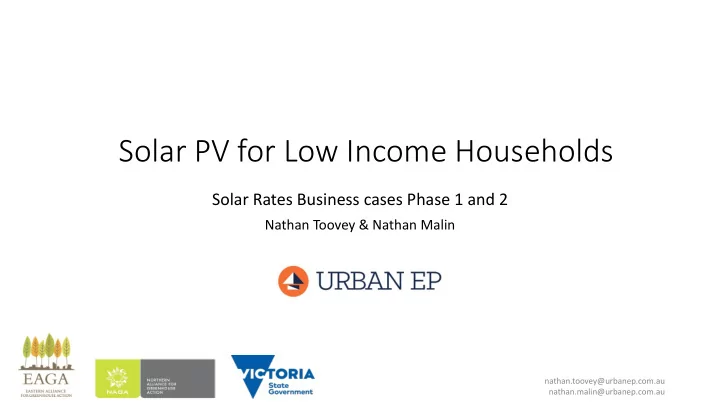

Solar PV for Low Income Households Solar Rates Business cases Phase 1 and 2 Nathan Toovey & Nathan Malin nathan.toovey@urbanep.com.au nathan.malin@urbanep.com.au
Structure The problem Solar $avers: an early program success Business case to upscale support Recommended path
Problem Energy poverty a recognised problem > Hardship provisions > Electricity and gas concessions … with private and public costs > Local community & adaptation plans > Limited scale pilot programs offering non-retail electricity solutions > Inadequate household cash reserves For some lower income households, > Limited access to suitable credit lowest cost energy may include onsite > Other disadvantages specific to sub-groups renewables but this may be off limits: > State support only for retail energy services For these households, the existing retail-focused government interventions are inefficient and ineffective solutions.
Opportunity About 52,000 owner occupier pensioners could be ready to benefit as a starting group
Darebin Sola lar $avers Outcomes: - 292 pensioner homes - Paid for via cash reserve - 0 % p.a. / 10 years - Total installed capacity 545 kW - Savings of $100 / year over loan years Challenges to replicate beyond Darebin: - Costs to recruit and engage - Special Rates mechanism - Reliance on council reserves
Solar Rates business case Opportunity across lower income households Owner-occupier pensioners ideal to start with Threshold terms of 5 % p.a. / 10 years Phase I Risk to lender a dominant variable to address Evidence base for NEJF application The value proposition Viable financing models Phase II Roles and services in delivery Legislative constraints Longer term considerations
New Energy Jobs Fund > Application for funding to support project staff (2.5yrs) > 20+ councils > Stream A - councils directly sponsoring installations (Special Charges) > Stream B - trialling bank loans directly to householder > Bank Australia providing sub 5% loans, 10 yrs > $50,000 default fund trial > Shared services model, leveraging Alliances > Up to 900 pensioner home owners > Strong focus on trialling models and evaluation
Valu lue proposition • Lower energy costs now and in future Owner occupier • Empowered to partake in energy market transformation pensioners • Finance mediated by existing relationships • Welfare gains to least advantaged community members Local governments • Climate change mitigation and adaptation outcomes • Scale carries opportunity to share costs and experiences • Better designed welfare interventions State government • Energy welfare and climate change co-delivered • Real public savings • Wider, fairer stake in renewable energy • Option to adapt to social and public housing • Ability to lend responsibly to households in need Lenders • Enhanced social licence to operate
Fin inancing paths and in interest rates Private finance with Gov guarantee Council rates: EUA Council rates: Special Charges + debt Risk transferred to state Risk remains with lender, council Risks to lender diminished when acts as collection intermediary council acts as borrowing intermediary
State government is is a fin inancial stakeholder Accepting a solar loan means a lower retail electricity concession ~$80 windfall gain to the state per year at home owner’s cost Home owner retains some risk, depending on their circumstances - May reduce interest and uptake across the 52,000 homes - May stymie the gains for household, concessions and climate action Victorian Government may want to: > share the risk in accordance with the benefit > improve the efficiency and equity of retail-only concessions
Combined state energy concessions + solar lo loans Finance path Household net savings Household net savings Concession savings and interest rate (during loan, per year) (after loan, per year) (after loan, per year) Scale constraint: cash reserves Council reserves: $161 - $282 $409 - $536 $87 - $109 0 % Council borrows: Scale constraint: $135 - $253 $409 - $536 $87 - $109 1.5 % debt appetite $116 - $233 $409 - $536 $87 - $109 2.5 % Direct bank loan: $68 - $181 $409 - $536 $87 - $109 Up to 5 % Scale constraint: household benefit
Shared services to deli liver at scale Pursue an ongoing statewide offering with: 1. Flexibility to aggregate with councils and partners 2. Ongoing improvements on loan terms 3. Inclusion of efficiency and thermal comfort benefits over time. Seek MAV to: • provide procurement services to the NEJF pilot • engage with the state government on support and legal reform Also engage MAV or banks to source funds at low interest rates, and test options to offload debt in line with debt tolerances. Work with Sustainability Victoria to identify and deliver integrated and complementary services.
Recommended path 1. State government to consider a rebate in line with concession savings. To aid uptake and create a buffer for households as they repay the loan. 2. Lower the Special Rates legal requirements for ‘opt in’ solar programs. To make it easier for councils to use special rates with council reserves and other funding sources. 3. Leverage the capabilities of MAV and Sustainability Victoria. 4. Continue to drive improvement. • Seek best possible sources of finance and lending terms • Build on the program to bring benefits for other low income segments • Apply knowledge gained to realise other energy and welfare benefits.
Thank you! Nathan Toovey 0432 391 835 nathan.toovey@urbanep.com.au Solar rates business case reports and related material: https://eaga.com.au/projects/solar-rates/
Recommend
More recommend